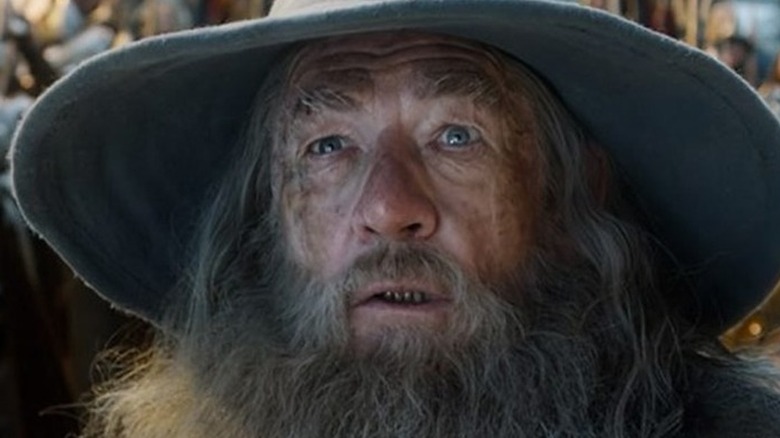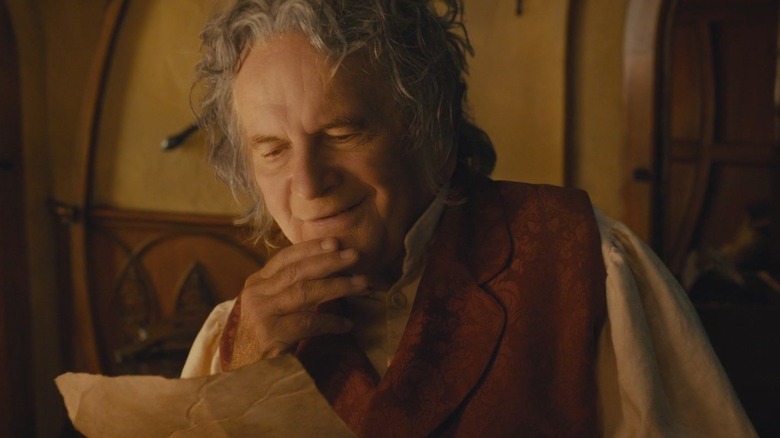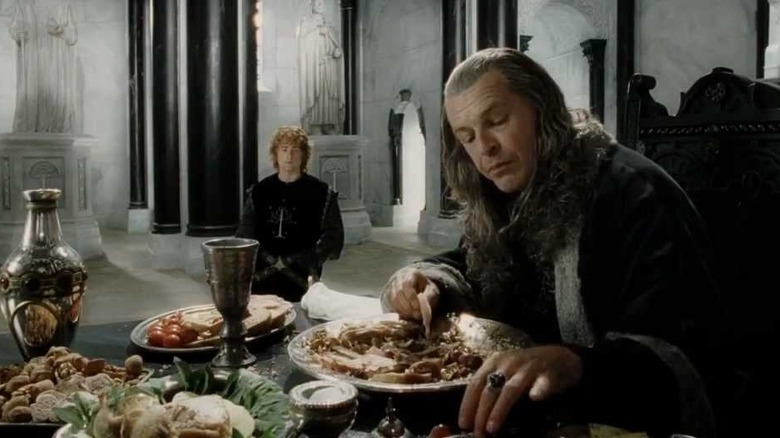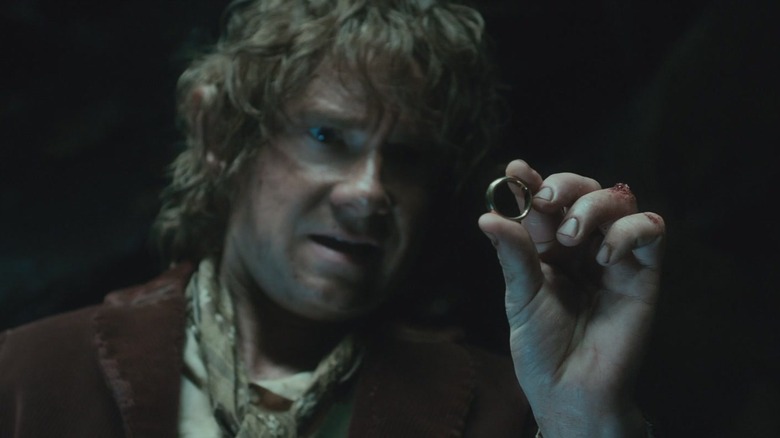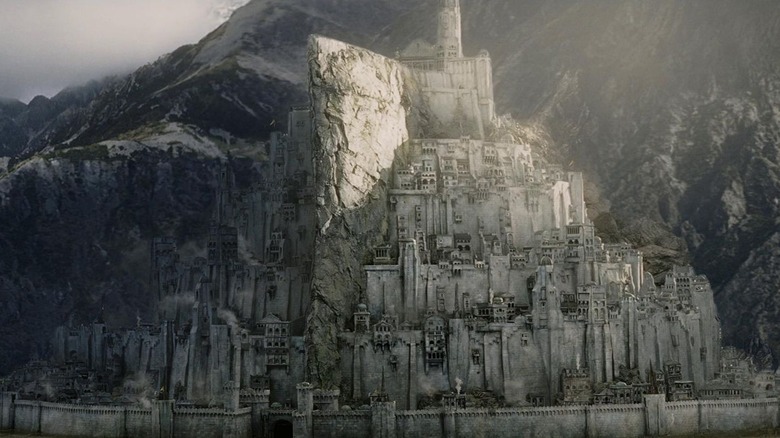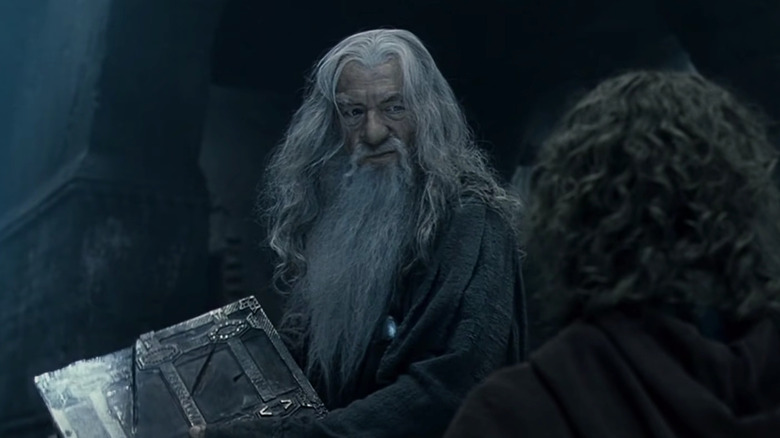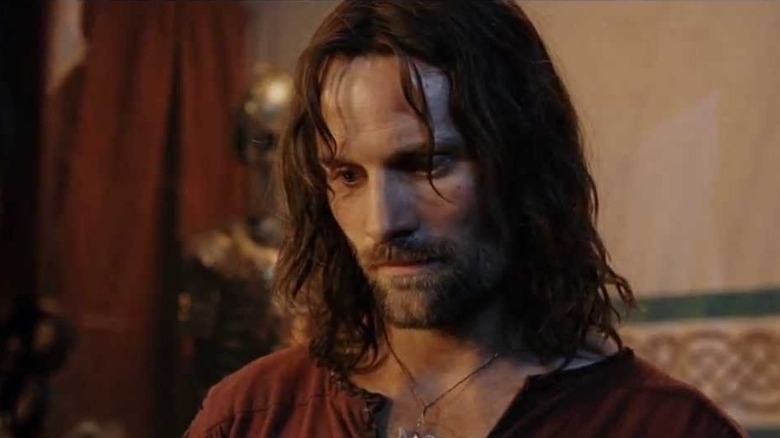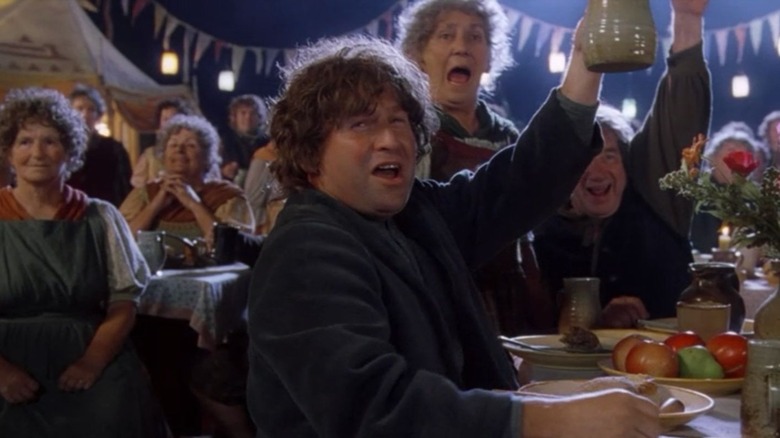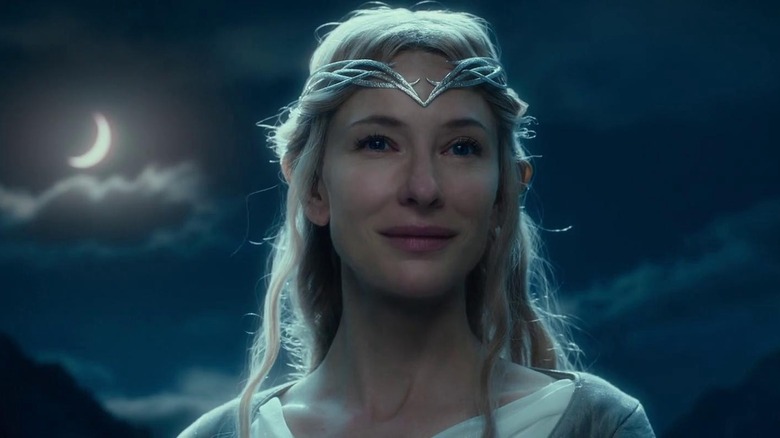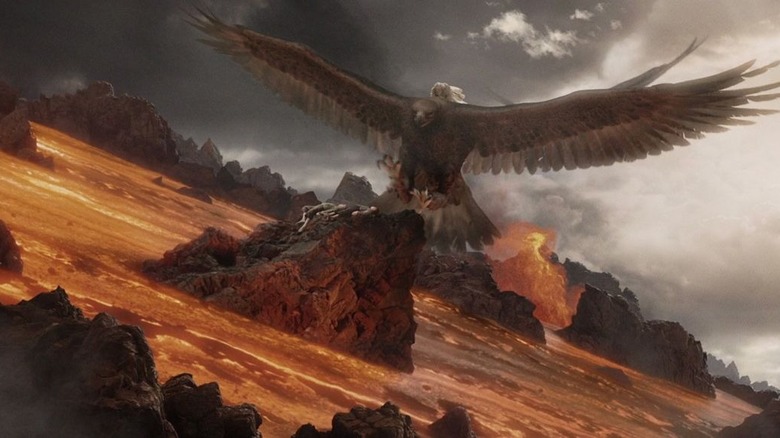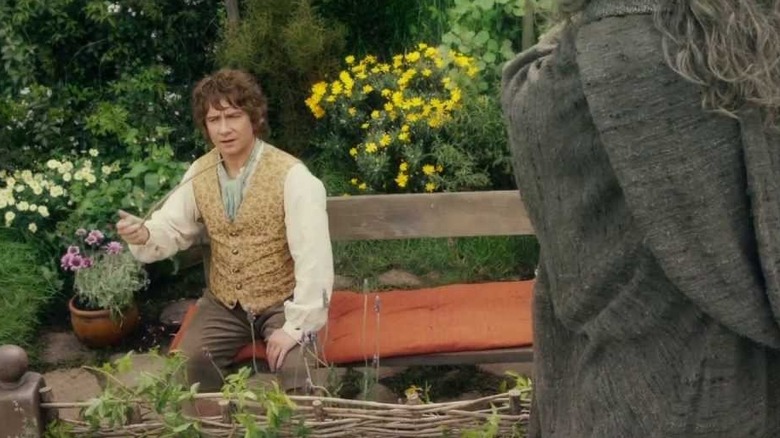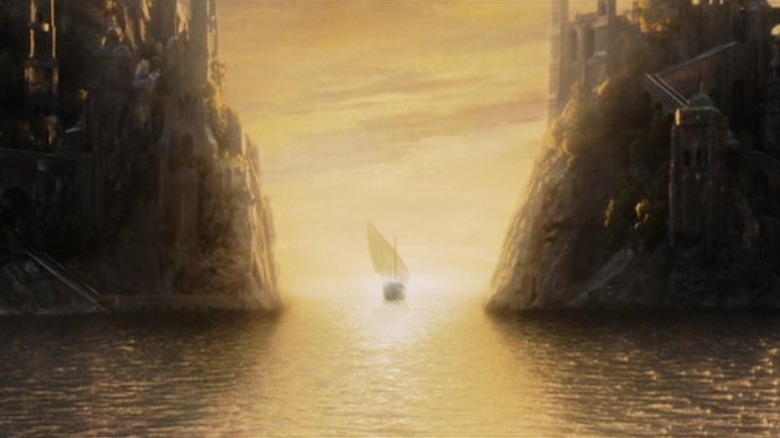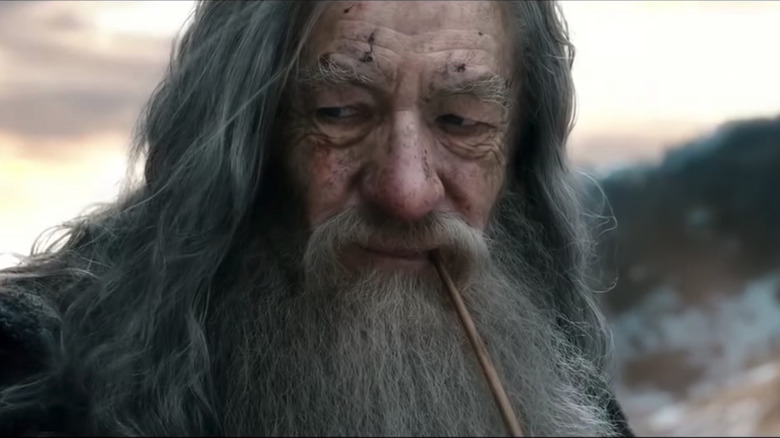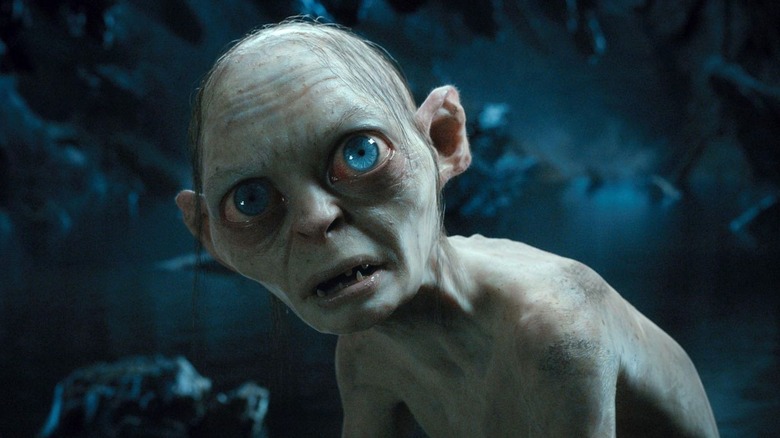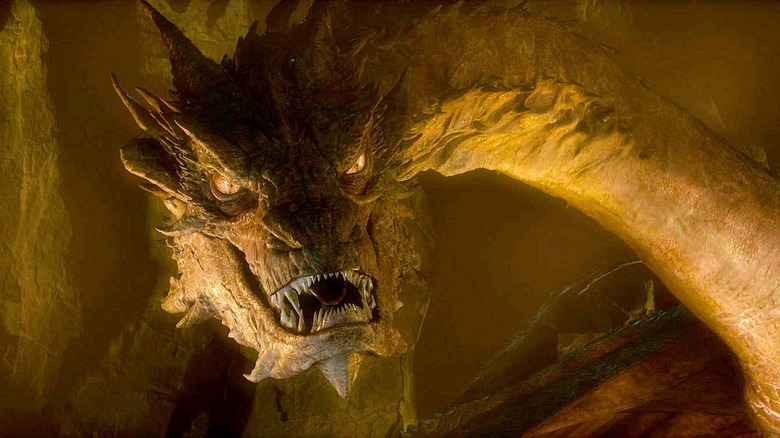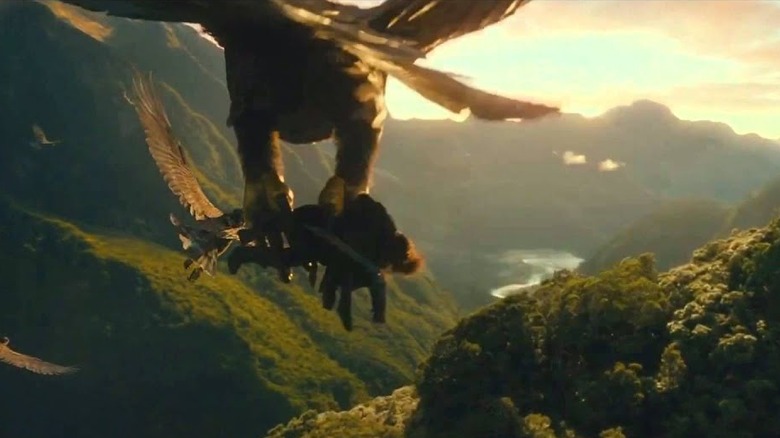Rules In Tolkien's Lord Of The Ring's Universe Explained
There are rules in every universe, even fantastical ones. Without them, it's difficult to achieve that immersive element that lets readers fully enter into the experience. Some of these rules are clearly defined, while others are unspoken. Some impact a single moment in time, and others are constantly being applied.
J.R.R. Tolkien spent decades creating and refining his world. The work started all the way back in 1917 and continued until his death over half a century later. After that point, his son, Christopher, continued the task by publishing many of the unfinished iterations of his father's world for its growing fan base to consume. This started with landmark books like "The Silmarillion" and went on to include epically exhaustive tomes like "Unfinished Tales," "The Letters of J.R.R. Tolkien," and the expansive 12-volume "History of Middle-earth." On top of the written material, multiple adaptations have been made, including Ralph Bakshi's animated "Lord of the Rings" films and Peter Jackson's iconic pair of Middle-earth trilogies.
With so much Middle-earth content out there, it's nice to step back every once in a while and consider what rules — both explicit and perceived — make the vast creation of Arda run on a daily basis.
Perspective is important
Throughout all of Tolkien's writings, he makes a big deal about whose point of view is being presented. This isn't an "in your face" kind of revelation. In fact, it's easy to miss. If you dig a little bit, though, the different perspectives scattered throughout the various Middle-earth texts provide an interesting blueprint for how the world is presented.
For instance, "The Silmarillion" is a book that's clearly told from an Elvish point of view. It deals with very lofty stories. It includes immortal characters. It "remembers" all the way back to the beginning of time. These are things that only Elves would know enough about to report on.
In contrast, "The Hobbit" is basically Bilbo's journal. It's part of an in-canon book called "The Red Book of Westmarch," which also includes Frodo's account of "The Lord of the Rings" and many other things supposedly written in Middle-earth. This is why "The Hobbit" is presented in such a different tone than "The Silmarillion." From Bilbo's perspective, Dwarves aren't seen as enemies or hostile — as they often are to Elves. They're Bilbo's silly coworkers, and eventually his friends. While it isn't always clear, the perspective of every piece of Tolkien's Middle-earth content is always important if you want to understand the story correctly.
Singing has real power in Middle-earth
Tolkien loved singing, poems, rhyming, and all that jazz. What can we say? The guy was a philologist through and through. He loved language. All that to say, the way things are spoken really mattered to Tolkien, and he put power behind those words. Multiple times, songs are used to not just evoke emotion, but to create actual physical responses in his work.
For instance, in the "Return of the King" book, Sam sings a song of despair after losing Frodo to Shelob and the Orcs. The tune causes Frodo to respond, saving the nearly disastrous situation. In the movie of the same name, Pippin's song that he sings to Denethor is directly played over Faramir's deadly charge on horseback.
Even more deliberate is the use of song in "The Silmarillion." For example, Galadriel's brother, Finrod, duels Sauron through a battle of songs. The Elf-maiden Lúthien sings a song so powerful that she's allowed to become a mortal, which might sound weird out of context, but trust us, it makes sense. Heck, the history of the entire world of Arda is literally created through a massive, complex angelic orchestra before time even begins. No matter where you go, singing is a big deal in Middle-earth.
Items and power are often linked
Middle-earth is modeled after a number of classic northern European myths. And it just so happens that those ancient tales are littered with trinkets and items that hold significant meaning and even — at times — inner power of their own. This in turn led Tolkien to imbue many of the items in his own world with their own unique powers. The most obvious example of this is the One Ring itself. There are also the many other Rings of Power, including the Nine for Mortal Men, the Seven for the Dwarf-lords, and the Three for the Elven-kings (and queens). But the power of personal items doesn't stop there — not by a long shot.
"The Silmarillion" is literally named after three bright, hallowed jewels. These contain their own inner light and potency, and their theft is what leads to the entire tragic First Age of Middle-earth history. The Arkenstone that Thorin covets in "The Hobbit" is also a holy jewel with its own inner light. And that doesn't even touch on all of the powerful weapons in "The Lord of the Rings."
Aragorn wields Andúril, a sword that even Sauron is scared of. Théoden has Herugrim, his ancient blade that he uses to lead his people in battle. Gandalf has Glamdring, another old sword with a nasty reputation and the nicknames "foe-hammer" and "Beater." Bilbo and Frodo have Sting, a sword that glows when enemies are near. In the First Age, the sword Gurthang even talks at one point. Suffice it to say, items and power go hand in hand everywhere in Middle-earth.
Middle-earth is a true universe
Storytelling is largely focused on universe-building these days. Every Marvel project has to tie in with the rest of the MCU, the DCEU somehow keeps on being kind of a connected thing, and "Star Wars" can't let go of the Skywalker tie-ins. Universes are hip, and everyone seems on board with the idea. It's a trend that Tolkien was way ahead of, too. The world-builder started off his franchise with some disconnected stories. He wrote a poem about Tom Bombadil. He worked on the tales that eventually made their way into "The Silmarillion." He wrote "The Hobbit" for his kids.
And then, inevitably, over time, he worked all of these stories together. The Gollum part of "The Hobbit" became the key that wove that story and "The Lord of the Rings" together — like, he literally rewrote it to make the One Ring more important. Tom Bombadil existed in Tolkien's early fanciful poetry, and then he landed a notable (if not so important) role in "The Fellowship of the Ring." Tolkien worked and reworked "The Silmarillion" until he died, and Christopher Tolkien wove the pieces together into a semi-coherent story that ends with the War of the Ring.
One way or another, most of what Tolkien wrote ultimately made its way into Middle-earth. Not only that, but the various stories managed to overlap and interconnect often. It's something that has become commonplace in modern fantasy, but let's not forget that this guy was working his crossover magic decades before it was a thing. Nice job, Tolkien. We salute you.
Language is really important
Tolkien loved language. It's such a big deal in his work that the showrunners for the "Rings of Power" series made it a priority to focus on how their characters speak. In an interview with Vanity Fair, Patrick McKay even went so far as to say that they made hero meters for each race, explaining that "Some of them will speak in iambs. Some of them will speak in dactyls. Some of them will speak in trochees."
This obsession with the language spoken is nothing new. Tolkien was busy inventing languages at a young age. He also focused academically on philology, a neglected branch of study that involves not just learning languages but actually studying language, itself, as a subject. This is why the writer poured so much thought into his world's languages. Practically every people group speaks their own unique tongue.
This starts with the Elves. In fact, in the foreword to "The Fellowship of the Ring," Tolkien literally states that he started creating Middle-earth for his own personal satisfaction, adding that "it was primarily linguistic in inspiration and was begun in order to provide the necessary background of 'history' for Elvish tongues." Over time, Tolkien ended up creating multiple Elvish languages, a secretive system of communication for the Dwarves, and the Black Speech of Mordor. Heck, even Hobbits — who speak the common language — get their own words. For instance, a "mathom" is a word Hobbits use as a casual reference to a trinket.
Ancestry matters - like, a lot
Middle-earth is a very medieval place. It doesn't just have Dark Age vibes, but also many old-school customs, one of which is the venerable respect for ancestry. Tolkien came from England, where your heritage was a really big deal at the time. This influence seems to have spilled right into his fantasy world, where a person's pedigree really matters.
This starts at the top. Royalty in Middle-earth stakes a biological claim early and often. In "The Silmarillion," the famous craftsman Fëanor (the fiery dude who forges the Silmarils) causes some major trouble when his claim to lead a faction of the Elves gets mixed up with the children of his father's second marriage. Obviously, Aragorn is another example of this powerful connection with kin. If you go back far enough (we're talking like 60 generations), Aragorn's claim to the kingship of Gondor goes right back to Elrond's twin brother, Elros, who was the first king of the Mannish land of Númenor.
Even outside of royalty, the ancestry factor remains strong. In "The Fellowship of the Ring," Tolkien narrates that "Hobbits have a passion for family history." In "The Two Towers," Gandalf warns Théoden that Hobbits will "sit on the edge of ruin and discuss the pleasures of the table, or the small doings of their fathers, grandfathers, and great-grandfathers, and remoter cousins to the ninth degree, if you encourage them with undue patience." Everyone and their mother cares about family connections in Middle-earth.
Hobbits love the simple pleasures of life
Hobbits love to enjoy life. You don't have to spell that rule out to understand it — it's everywhere. The opening sequences of both the book and movie version of "The Fellowship of the Ring" bear it out clearly. We see Hobbits running their quiet, rural lives, smoking their pipeweed, and kicking up their feet whenever they can. They drink plenty of beer, they have lots of laughs, and of course, they love to eat.
In fact, food is a special part of any Hobbit's life. For goodness sake, what's the line from "The Fellowship of the Ring" that we all bring up any time an unplanned meal takes place? "What about second breakfast?" Pippin doesn't stop there, either. He inquires about other Hobbit mealtime staples, including elevensies, luncheon, and afternoon tea, before ending on the one-two punch of dinner and supper.
Even Hobbit children eat a lot. In the "Fellowship of the Ring" book, Tolkien explains that many parents bring their kids to hear Bilbo's speech because it's a chance to get them a free meal, adding that "bringing up young hobbits took a lot of provender." From good eating to lazy days and nights spent drinking and smoking, Hobbits know how to take life one step at a time.
Elves don't mature the same as Men
When you think of an immortal person, it's easy to get confused about the details. How fast do they grow? Is their mental and emotional maturity equivalent to a mere mortal? It turns out that Tolkien grappled with this stuff, too, and he ultimately did his best to work out some formal rules.
Now, in this case, we're talking about very unpublished material — as in scraps and notes that were found after Tolkien died. Even so, Carl F. Hostetter pieces many of these fragments together in the book "The Nature of Middle-Earth." One section of this book has to do with how Elves age and mature. In it, Hostetter points out that there are a couple of different ways that Elves age in Tolkien's work, but they generally follow the same basic timeline. Generally, the process involves a "fast" growth period of hundreds of years until the Elves reach the equivalent age of a 20-year-old mortal, at which point their maturity slows way down. One of Tolkien's "Elvish maturity formulas" puts Galadriel at roughly the same maturity level as a 28-year-old when the Second Age begins. Another puts Elrond at the maturity of a 27-year-old human when the War of the Elves and Sauron breaks out after the One Ring is forged.
The abbreviated version of all of this? While the math varied over Tolkien's life, he made an effort to ensure that Elves mature much slower than Men, making members of both groups genuine peers in the process.
Eucatastrophes are par for the course
If you haven't heard of the term "eucatastrophe," that's probably because Tolkien invented it. In a letter written to his son during World War II, he literally says, "I coined the word 'eucatastrophe': the sudden happy turn in a story which pierces you with a joy that brings tears (which I argued it is the highest function of fairy-stories to produce)." Tolkien adds, "And I was there led to the view that it produces its peculiar effect because it is a sudden glimpse of Truth, your whole nature [...] feels a sudden relief as if a major limb out of joint had suddenly snapped back."
This need to evoke joy, inspire happiness, and show a glimpse at a larger truth is a recurring theme throughout Tolkien's works. Sometimes these eucatastrophic moments are small — like Bilbo finding the One Ring. At other times, they're epic. The Eagles showing up at the Battle of the Five Armies in "The Hobbit" and at Mordor in "The Return of the King" are great examples. Gollum accidentally helping to destroy the One Ring by slipping and falling is another instance of eucatastrophe. It's that sudden turn that ultimately brings success for the good guys, and it's a theme that runs very deep in Tolkien's works.
Hobbits don't go on adventures
Hobbits don't go on adventures. They just don't. Okay, they occasionally do, and we know five Hobbits in particular who have gone on world-changing adventures. But throughout all of "The Hobbit" and "The Lord of the Rings," Tolkien regularly reiterates the fact that this is a very unusual occurrence. In fact, it's downright condemned by the Hobbits themselves.
Just a few pages into "The Hobbit," Bilbo describes Gandalf as being "responsible for so many quiet lads and lasses going off into the Blue for mad adventures." He goes on to describe the wizard's adventure-inducing resume as including everything from "climbing trees" to "visiting Elves" and "sailing in ships." He ends with the fact that Gandalf used to upset things in the Shire quite severely, even before he coaxes Bilbo and Frodo into their own adventures.
Of course, just because most Hobbits disdain adventure doesn't mean they all do. The Took family — a large branch of Hobbits that includes Pippin, Frodo, and Bilbo — gains a very real reputation as trouble makers and leaders who are willing to take risks. In general, though, if you meet a Hobbit, they're probably going to want to avoid any excitement. In the words of Elijah Wood's Frodo, Hobbits (and especially Bagginses) "never had any adventures or did anything unexpected" before Gandalf came along.
Elves are always susceptible to the calling of the sea
The Elves love the sea — full stop. The enchanting sounds of Middle-earth's oceans call to the Elves from a very early time in Tolkien's writings. They can have lives away from the ocean, but once they get that "sea itch," it doesn't go away until they've scratched it. Legolas is a great example of this. The woodland Elf spends grows up in the dark undergrowth of Mirkwood. He's the Elvish princeling of an underground kingdom where the closest body of water of any note is the Long Lake near the Lonely Mountain.
And yet, at one point, Galadriel sends Legolas a prophetic message of warning: "In joy thou hast lived. Beware of the Sea! If thou hearest the cry of the gull on the shore, Thy heart shall then rest in the forest no more." Later, in the lead-up to the Battle of the Pelennor Fields, Legolas hears those gulls and responds by saying "Alas for the wailing of the gulls! Did not the Lady tell me to beware of them? And now I cannot forget them."
Legolas continues on with his adventure. After it ends, he heads home and even comes back to live in Gondor for a while. But the need to go to the sea — and to cross over the water to the Blessed Realm beyond it — remains firmly fixed in his heart. Eventually, he must respond and leave Middle-earth, which he does. This same theme comes up with many other Elves all over Tolkien's writings.
Everything is under control
Tolkien was a Catholic, and it's no secret that his deep personal faith percolated into his stories in a number of ways. Some of his world's biggest themes are the presence of a Creator, a predetermined history, and a greater purpose lying behind everything that happens. In a sense, these can be seen as some of the biggest "rules" of Middle-earth since they set the tone for practically everything that happens.
Of course, just because there's Eru Ilúvatar – the creator deity of Tolkien's world who's also called "The One" — doesn't mean that his presence is felt all the time. In fact, Tolkien constantly allows his characters to impact the greater narrative with their own decisions. Even so, every once in a while, he provides a subtle reminder that everything really is under the control of a higher power.
For instance, at the end of "The Hobbit," Gandalf points out that prophecies come true in Middle-earth, adding that Bilbo shouldn't believe his various escapes and adventures were simply luck. The eucatastrophic presence of the Eagles saving the day is another manifestation of a higher power. In earlier writings, Tolkien even incorporated a prophesied, apocalyptic "Last Battle" called the Dagor Dagorath, although Christopher Tolkien says his father abandoned that idea later on. Regardless, the larger themes of destiny and a higher power run strong throughout Middle-earth's long history.
Everything is official, but very little is set in stone
One of the more interesting unspoken rules of Middle-earth is that everything written is canon, but that doesn't necessarily mean that it's true. What does that mean, exactly? Consider this.
The original "Hobbit" story features a Gollum who's interesting, quirky, and only kind of bad. But he's literally apologetic when he realizes he lost his Ring and can't give it to Bilbo. When Tolkien went on to write "The Lord of the Rings," he changed things. Gollum became more sinister, and the Ring became the One Ring. Rather than simply retconning the original version of events, though, Tolkien incorporated it into Bilbo's own story, tying it in with the Hobbit's original, lie-filled account of the encounter. This is explained in the prologue to "The Fellowship of the Ring," which adds that Bilbo's account was left untouched, even though Sam and Frodo knew the truth. Per the narrator, "they seem to have been unwilling to delete anything actually written by the old hobbit himself."
This is just one small example of how Tolkien evolved his world. Very rarely do you find a fully changed character. Instead, the author attributes alterations and improvements to something like a point of view change or a difference in translation. The result is a world where everything is a legitimate part of the legendarium, but where very few facts are indisputably trustworthy.
Never laugh at live dragons
One Middle-earth mantra that comes directly from the pages of Tolkien's text is the aphorism "never laugh at live dragons." The pithy statement comes from Bilbo's first verbal encounter with Smaug. He and the Dwarves arrive on the dragon's premises, find the secret door, and enter the mountain. Eventually, Bilbo creeps down into Smaug's lair, and at one point he even has a proper conversation with Smaug.
After the conversation ends in the book, Bilbo shoots a saucy parting remark that sparks the Golden Dragon's rage. Smaug sends spouts of flame after Bilbo, who flees up a small tunnel and manages to escape. Even so, we hear that Mr. Baggins' feet are scorched, and the Hobbit is nearly turned into a torch by Smaug's fiery breath.
As Bilbo escapes the inferno, the book reads: "'Never laugh at live dragons, Bilbo you fool!' he said to himself, and it became a favourite saying of his later, and passed into a proverb." In other words, that direct experience that Bilbo has with Smaug doesn't just teach him that laughing at Dragons is a really bad idea. It also yields a proverb that ends up being repeated by people everywhere. Doubtlessly, Bilbo helped protect countless other people around Middle-earth from their own dragon-induced mishaps.
Don't bring up the Eagles - just don't
This rule is more of an out-of-universe guideline than an actual hard-and-fast rule that dictates how Middle-earth functions. Even still, it stands: Don't bring up the Eagles.
If you have any connection at all to the "Lord of the Rings" franchise, you're probably familiar with the Great Eagle Debate. Why didn't the giant birds help more? Why didn't they fly the One Ring to Mount Doom themselves? The truth is, there are a lot of thorough answers to these questions out there, ranging from the mystical nature of the Eagles to their relationship with Gandalf. Still, most Tolkien fans are tired of these questions — tired of explaining why the Eagles don't just shortcut the whole "destroying the One Ring" business by flying it to Mount Doom and dumping it in, air-mail style.
The "rule" here, as it were, is that most fans just don't want to keep addressing the issue every 10 seconds. The story is the story, and the Eagles play their part.
